Table of Contents
THE CONTEXT: Addressing the nation from the Red Fort on the 75th Independence Day, Prime Minister said, “Be it the rice distributed through ration shops or the rice provided to children in the mid-day meal, the rice available through every scheme will be fortified by the year 2024.” In this article, we will analyse what is biofortification and its role in tackling the hidden hunger across the life cycle.
ALL YOU NEED TO KNOW ABOUT BIOFORTIFICATION
What is Biofortification?
- Biofortification is the process by which the nutritional quality of food crops is improved through agronomic practices, conventional plant breeding, or modern biotechnology.
- Biofortification differs from conventional fortification in that biofortification aims to increase nutrient levels in crops during plant growth rather than through manual means during processing of the crops.
- Biofortification may therefore present a way to reach populations where supplementation and conventional fortification activities may be difficult to implement and/or limited.
Examples of Biofortification projects include: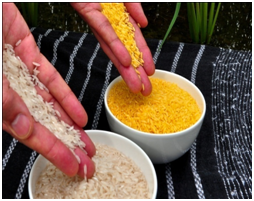
- Iron-biofortification of rice, beans, sweet potato, cassava and legumes;
- Zinc-biofortification of wheat, rice, beans, sweet potato and maize;
- Provitamin A carotenoid-biofortification of sweet potato, maize and cassava; and
- Amino acid and protein-biofortification of sorghum and cassava.
- The far bowl on the right contains Golden Rice, an example of biofortification using genetic engineering. The golden color of the grains comes from the increased amounts of beta-carotene a precursor of vitamin A.
FORTIFICATION Vs BIOFORTIFICATION
FORTIFICATION
- Fortification is the deliberate addition of key vitamins and minerals such as Iron, Iodine, Zinc, Vitamins A & D to staple foods such as rice, wheat, oil, milk and salt to improve their nutritional content.
- These nutrients may or may not have been originally present in the food before processing or may have been lost during processing.
- It does not alter the characteristics of the food like the taste, aroma or the texture of the food.
- Hence fortification of food is a safe method of improving nutrition among people as the addition of micronutrients to food does not pose a health risk to people.
BIOFORTIFICATION
- Biofortification is a feasible and cost-effective means of delivering micronutrients to populations that may have limited access to diverse diets and other micronutrient interventions. Research efforts have demonstrated that this agriculture-based method of addressing micronutrient deficiency through plant breeding works.
- Biofortification is targeted primarily to the rural poor who rely heavily on locally produced staple foods as their primary source of nutrition, and who often have restricted financial or market access to commercially processed fortified foods
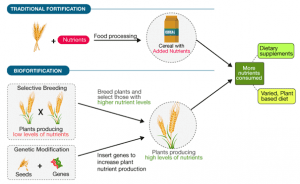
IMPORTANCE OF NUTRITION
- Essential nutrients are compounds that the body can’t make or can’t make in sufficient quantity. According to the World Health Organization, these nutrients must come from food, and they’re vital for disease prevention, growth, and good health.
- Despite this there is a decline in the percentage of the number of women and children suffering from anaemia in the past few years, the high absolute numbers are worrying. Incidentally, anaemia accounts for 20% of the maternal deaths that take place in the country.
- As such, biofortification is seen as an upcoming strategy for dealing with deficiencies of micronutrients in low and middle-income countries. In the case of iron, the WHO estimated that biofortification could help curing the 2 billion people suffering from iron deficiency-induced anemia.
NUTRITIONAL STATUS OF INDIA
Global Hunger Index 2021
- In the 2021 Global Hunger Index, India ranks 101st out of the 116 countries with sufficient data to calculate 2021 GHI scores. With a score of 27.5, India has a level of hunger that is serious, published by Concern Worldwide and Welthungerhilfe.
- It is calculated on the basis of four indicators: Child nourishment, Child wasting, Child Stunting and Child Mortality.
The Food and Agriculture Organization (FAO) estimates that 194.4 million people in India (about 14.5% of the total population) are undernourished.
According to the National Family Health Survey (NFHS-4):
- 4% of children (6-59 months) are anemic
- 1% women in the reproductive age group are anemic
- 7% of children under 5 are underweight
- Also, It is estimated that 50-70% of these birth defects are preventable. One of the major causes is deficiency of Folic Acid.
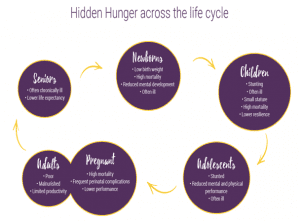
HIDDEN HUNGER AND EMPTY CALORIES
- Hidden hunger is the term use to describe the deficiencies in micronutrients such as zinc, iron and vitamin A can cause profound and irreparable damage to the body—blindness, growth stunting, mental retardation, learning disabilities, low work capacity, and even premature death.
- The effects of hidden hunger are acute during the first 1,000 days of a child’s life—from conception to the age of two years. Micronutrient deficiencies are especially damaging to women. Five hundred million women aged 15 to 49, at the peak of their productive years, are anemic due to iron deficiency. This condition reduces their productivity, decreases their economic potential, and affects their reproductive health outcomes. With the fast growing urbanisation, and urban to rural migration paves the way for packaged food items and readily consumables that are need to be addressed with nutritional values.
- This approach may have advantages over other health interventions such as providing foods fortified after processing, or providing supplements. Although these approaches have proven successful when dealing with the urban poor, they tend to require access to effective markets and healthcare systems which often just do not exist in rural areas. Biofortification is also fairly cost effective after an initial large research investment – where seeds can be distributed, the “implementation costs [of growing biofortified foods] are nil or negligible”, as opposed to supplementation which is comparatively expensive and requires continued financing over time, which may be jeopardized by fluctuating political interest.
- Research on this approach is being undertaken internationally, with major efforts ongoing in Brazil, China and India.
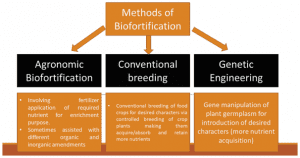
HOW BIOFORTIFICATION HELPS IN ADDRESSING INDIA’S DEFICIENCY?
- Biofortified crops are rich in iron and have the potential to improve iron status and cognition. That helps in improving the overall health of human.
- Biofortified crops are also often more resilient to pests, diseases, higher temperatures, drought and provide a high yield.
- Biofortification fills an important gap as it provides a food-based, sustainable and low-dose alternative to iron supplementation. It does not require behavior change, can reach the poorest sections of the society, and supports local farmers.
- After the initial investment to develop the biofortified seed, it can be replicated and distributed without any reduction in the micronutrient concentration. This makes it highly cost-effective and sustainable.
- Considering the various implementation barriers faced by genetically modified crops in India, biofortification which can be done through non-genetically-modified methods as well can be a better alternative. So far we are focusing on
VARIOUS MEASURES TAKEN BY THE GOVERNMENT
- National Nutrition Strategy by NITI Aayog, Government of India envisages alleviation of malnutrition in the country through food-based solution.
- Integrated Child Development Services (ICDS) by Women and Child Development Ministry which provides a package of six services namely supplementary nutrition, pre-school non-formal education, nutrition & health education, immunization, health check-up and referral services.
- Inclusion of these biofortified cereals in different government sponsored programmes such as National Food Security Mission,Rashtriya Krishi Vikas Yojana as well as nutrition intervention programme such as Integrated Child Development Services scheme, ‘Mid-day meal’ and Nutrition Education and Training through Community Food and Nutrition Extension Units would help in providing the much needed balanced food to poor people.
- National Nutrition Mission: To reduce stunting and wasting by 2 per cent per year (total 6 per cent until 2022) among children and anaemia by 3 per cent per year (total 9 per cent until 2022) among children, adolescent girls and pregnant women and lactating mothers.
- The central government has recently declared millets (sorghum, pearl millet, foxtail millet, finger millet, kodo millet, proso millet, little millet and barnyard millet) besides two pseudo millets (buck-wheat and amaranthus) which have high nutritive value as ‘Nutri Cereals’.
- The inclusion of biofortified products in these government-sponsored schemes would especially benefit the children, pregnant women and elderly people, and would help in their quick dissemination.
CHALLENGES FOR BIOFORTIFICATION IN INDIA
- Lack of consumer acceptance due to color changes (e.g. golden rice) and last mile reach of fortified food remains a big challenge.
- Adoption of farmers and cost involved in the process of fortification also poses a challenge for biofortification in India.
- Though biofortification can be done using non-genetically-modified methods it is a slower process than genetic modification.
- The lack of an effective seed and rural extension system for multiplication and dissemination of new varieties will also pose a challenge.
RECENT DEVELOPMENTS
- Vallabhhai Vasrambhai Marvaniya, a farmer scientist from Gujarat has developed Madhuban Gajar,
 a biofortified carrot variety with high β-carotene and iron content.(He has been conferred with a National Award by the President of India during Festival of Innovation (FOIN) in 2017 and was also conferred with Padma Shri in 2019 for his extraordinary work in this field).
a biofortified carrot variety with high β-carotene and iron content.(He has been conferred with a National Award by the President of India during Festival of Innovation (FOIN) in 2017 and was also conferred with Padma Shri in 2019 for his extraordinary work in this field). - Madhuban Gajar has been cultivated in over 1000 hectares of land in Gujarat, Maharashtra, West Bengal, Rajasthan and Uttar Pradesh.
- It is used for several value-added products like carrot chips, juices, and pickles.
- It possesses a significantly higher root yield and high plant biomass.
- It has been tested by National Innovation Foundation (NIF) of India, an autonomous institute under the Department of Science and Technology during 2016-17.
THE WAY FORWARD:
- The lack of nutrition is not only a denial of a fundamental human right, but it is also poor economics. Biofortification is a partial solution, which must go hand in hand with efforts to reduce poverty, food insecurity, disease, poor sanitation, social and gender inequality.
- Increasing Maternal Health Literacy, ending societal discrimination faced by women and adolescent girls, making healthcare and proper sanitation accessible will also help in eradicating malnutrition.
- The government should facilitate public-private partnerships. Private sector engagement can leverage technological solutions for scaling up food fortification initiatives, and complement the government’s outreach efforts through mass awareness and education campaigns in communities.
- There is a need to shift dietary patterns from cereal dominance to the consumption of nutritious foods such as livestock products, fruits and vegetables, pulses, etc. Diverting a part of the food subsidy on wheat and rice to more nutritious foods can help.
- Strategies for delivery of biofortified crops must be tailored to the local context for each crop–nutrient pair.
- New Agricultural techniques: Achieving zero hunger requires agriculture and food systems to become more efficient, sustainable, climate-smart and nutrition-sensitive. India must adopt new agricultural technologies of bio-fortifying cereals, such as zinc-rich rice, wheat, iron-rich pearl millet, and so on.
THE CONCLUSION: Biofortification is a delicate technique that needs elaborate study to assess effect of alteration on human body. Thus, biofortification is indeed a novel way to reduce global hunger in areas of large population and high poverty. Proper planning and implementation can contribute towards reducing poverty using biofortification.
Spread the Word

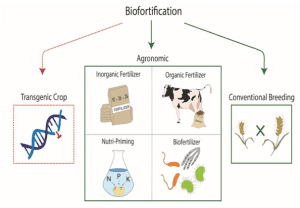
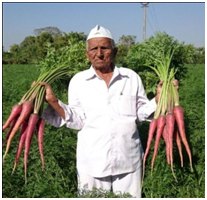 a biofortified carrot variety with high β-carotene and iron content.(He has been conferred with a National Award by the President of India during Festival of Innovation (FOIN) in 2017 and was also conferred with Padma Shri in 2019 for his extraordinary work in this field).
a biofortified carrot variety with high β-carotene and iron content.(He has been conferred with a National Award by the President of India during Festival of Innovation (FOIN) in 2017 and was also conferred with Padma Shri in 2019 for his extraordinary work in this field).